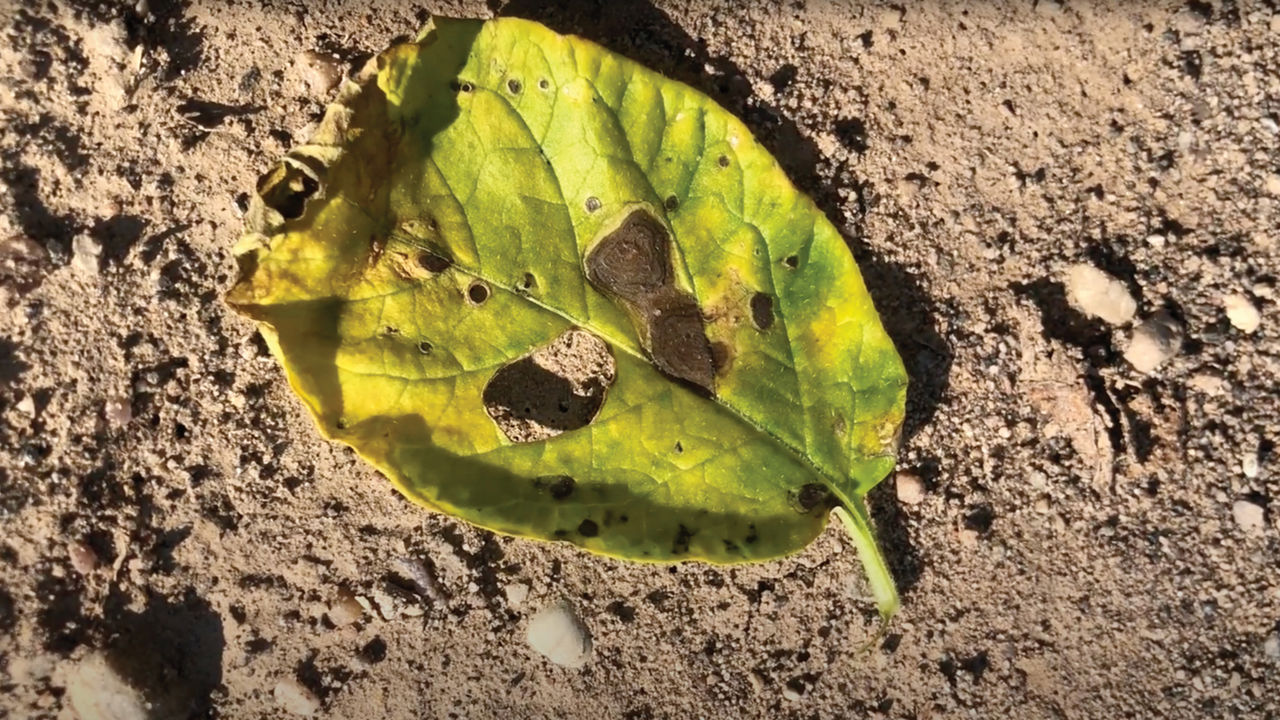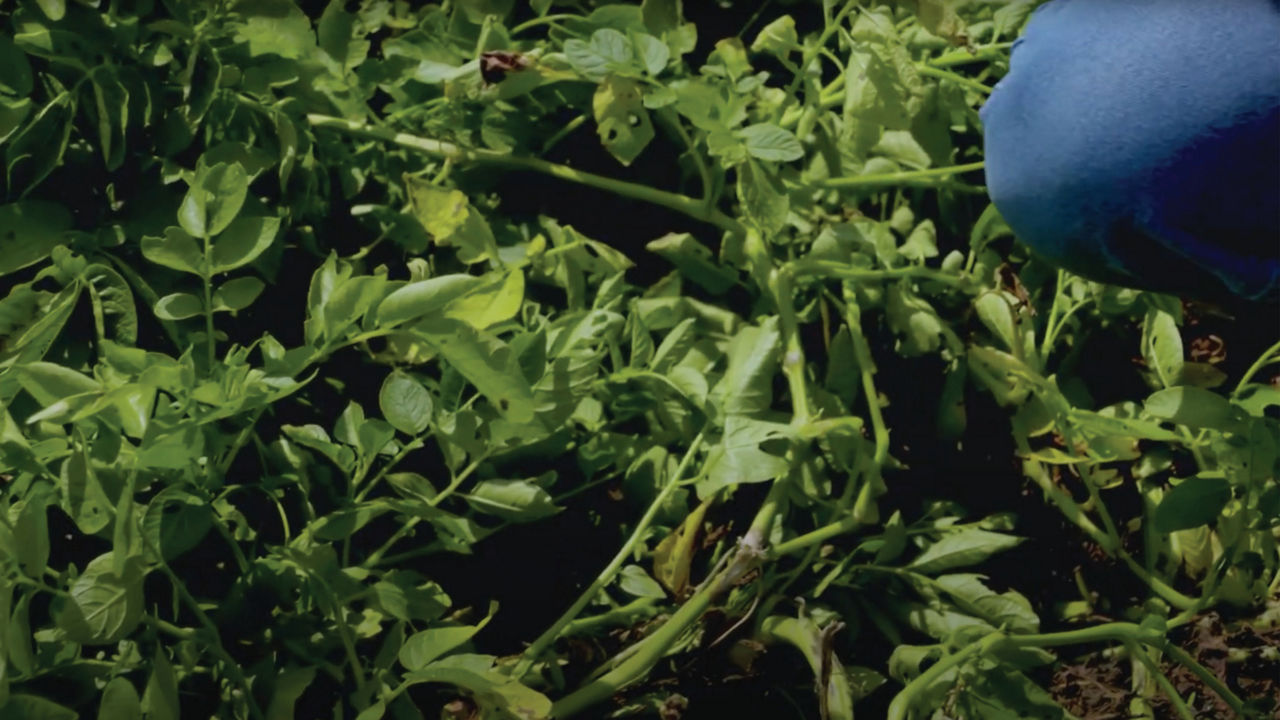Early Blight of Potato
March 14, 2024

- Early blight is a common disease of potatoes that can affect leaves, stems, and tubers reducing yield, tuber size, and marketability.
- Foliar symptoms of early blight infection include circular, dark-brown or black lesions with a concentric ring pattern that first appear on older, lower leaves. Tuber symptoms appear after harvest as dark-colored, sunken lesions on the tuber surface.
- Management includes the integration of cultural practices and the application of foliar fungicides. Explore more about Bayer fungicides and their other products in the Crop Protection Catalog.
Introduction
Early blight (Alternaria solani) of potato is found in most potato growing areas annually. The disease affects leaves, stems, and tubers and can reduce yield, tuber size, storability of tubers, quality of fresh-market and processing tubers, and marketability of the crop. Foliar infection is the most important phase of the disease in the Eastern United States, whereas in the western portion of the country, tuber infection can be more damaging. The disease can also be severe on tomatoes and can occur on other solanaceous crops and weeds.
Symptoms
Foliar symptoms of early blight first appear as small, irregular to circular dark brown spots on the lower (older) leaves. As these spots enlarge, they become restricted by larger leaf veins and take on an angular shape. Leaf lesions are easy to identify because lesion development is characterized by a series of dark concentric rings alternating with bands of light tan tissue giving them a target spot appearance. Multiple lesions on the same leaf also may coalesce, or grow together, to form one mass. Elongated, brown to black lesions also may develop on stems and petioles of infected plants. Stem lesions are an indication of a serious early blight outbreak in a field. Severely infected leaves eventually wither and die but may remain attached to the plant.
Time from initial infection to appearance of foliar symptoms is dependent on environmental conditions, leaf age, and cultivar susceptibility. Early blight is principally a disease of aging plant tissue. Lesions generally appear quickly under warm, moist conditions on older foliage and are usually visible within five to seven days after infection.
Tubers can be infected as they are lifted through the soil at harvest. If sufficient moisture is present, spores germinate and infect the tubers. The disease that forms in storage due to this spore transfer is referred to as tuber blight. Tuber symptoms include irregular to circular lesions that are slightly sunken and often are surrounded by a raised purple to dark brown border. The underlying tissues are leathery to corky in texture, dry, and usually dark brown. As storage progresses, the skin lesions enlarge, turn watery with a yellowish decay, and in time the tubers shrivel. Early blight tuber lesions develop slowly and may not be severe until after several months into the storage period.

Disease Cycle
Between crops, the early blight fungus can overwinter on potato debris in the field, in soil, on tubers, and on other susceptible solanaceous crops and weeds, including nightshade species. Overwintering spores can withstand a wide range of environmental conditions. In spring, conidia spores serve as the primary inoculum to initiate disease. Infection occurs when spores of the fungus contact susceptible leaves and sufficient free moisture is present. Alternating wet and dry periods with temperatures in the range between 41°F and 86°F (optimum is 68°F) favor spore development. Spores landing on leaves of susceptible plants germinate and may penetrate host epidermal cells directly or enter through stromata or wounds. Many cycles of early blight spore production and lesion formation occur within a single growing season. The rate of infection in the early season is generally low but increases after flowering and is most rapid during tuber bulking later in the season.
Management
Effective management of this disease requires an integrated disease management approach. Early blight is primarily controlled with cultural practices and foliar fungicides.
Cultural practices, such as crop rotation and eradicating weed hosts such as nightshade and horsenettle, help reduce the inoculum level for subsequent plantings. Early blight persists in plant debris from one growing season to the next, so rotation to non-host crops such as small grains, corn, and soybean for two to three seasons helps reduce the amount of inoculum available for infection. Other cultural controls include timing irrigation to minimize the duration of leaf wetness, practicing fall tillage that buries plant residue, and using certified disease-free seed. The disease is often associated with crops suffering from a lack of nitrogen, particularly toward the end of the growing season on older, senescing foliage. Management of other diseases will help reduce plant stress and minimize early blight severity. Storing tubers in conditions that promote rapid suberization helps minimize infection after harvest.
Cultivars vary in their susceptibility to early blight and no commercially produced potato cultivar is resistant to the disease. Field resistance to foliage infection is associated with plant maturity. Since the disease favors older, senescing leaf tissue, cultivars with an earlier maturity are slightly more susceptible to early blight compared to later maturing cultivars. Potato is relatively resistant to early blight in the vegetative stages, but susceptibility gradually increases after tuber and fruit initiation, and mature plants are very susceptible to the pathogen.
Regular scouting of fields after plants reach 12 inches in height is recommended to detect early infections. The physiological day (P-Day) calculation can be used to predict the development of the potato plants and the potential for disease infection. Early blight risk is elevated after 300 P-Days (physiological days) have accumulated after crop emergence. Early blight management actions are recommended beyond that point.
The most common and effective control method for early blight is the application of foliar fungicides. Bayer offers several fungicide options for management of early blight in potatoes (Table 1). Fungicides that contain the active ingredient fluopyram, including Luna Tranquility® Fungicide, Luna Pro® Fungicide, and Velum® Rise Fungicide/Nematicide have been shown to protect potatoes from early blight and other foliar fungal disease. Velum® Rise potato fungicide/nematicide is the newest member in a line of crop protection products designed to ensure your potatoes growth throughout their first 75 days when they are most vulnerable to pests and disease. Fluopyram is a systemic fungicide that has uniform uptake by the plant tissues which enables the product to enter and protect buds, blooms, and new tissues. Both Luna Tranquility® and Luna Pro® are combination products that include a mix of fluopyram (FRAC 7) with fungicides in other FRAC groups to help protect against the development of fungicide-resistant pathogen strains. For more information on Bayer fungicide products in potato, visit https://www.cropscience.bayer.us/learning-center/ipm-program-potato-portfolio to learn more about the 75 Day IPM Program for Potatoes.
Table 1. Bayer fungicides for early blight management.
Product |
Active Ingredient |
FRAC Group |
PHI (days) |
Luna Pro® Fungicide |
Fluopyram Prothioconazole |
7 3 |
17 |
Luna Tranquility® Fungicide |
Fluopyram Pyrimenthanil |
7 9 |
7 |
Previcur® Flex fungicide |
Propamocarb hydrochloride |
28 |
14 |
Scala® brand SC fungicide |
Pyrimethanil |
9 |
7 |
Serenade® ASO |
Baccilus subtilis strain QST 713 |
44 |
0 |
Velum® Prime insecticide |
Fluopyram |
7 |
7 |
Velum® Rise Fungicide |
Fluopyram Penflufen |
7 7 |
In Furrow |
*Always read and follow label directions.
Sources
Nuñez, J. and Aegerter, BJ. March 2019. Early blight. Potato Pest Management Guidelines. UC IPM. University of California.
https://ipm.ucanr.edu/agriculture/potato/early-blight/.
Bauske, MJ, Robinson, AP, and Gudmestad, NC. June 2018. Early blight in potato. PP1892. North Dakota State University.
https://www.ndsu.edu/agriculture/ag-hub/publications/early-blight-potato.
Kemmit, G. 2013. Early blight of potato and tomato. The American Phytopathological Society (APS).
https://www.apsnet.org/edcenter/disandpath/fungalasco/pdlessons/Pages/ PotatoTomato.aspx.
Gevens, AJ. Disease severity values and P-Days. UW Vegetable Pathology. University of Wisconsin.
https://vegpath.plantpath.wisc.edu/dsv/
Early blight. Cropwatch. University of Nebraska-Lincoln.
https://cropwatch.unl.edu/potato/early_blight.
Websites verified 6/15/2023
The recommendations in this article are based upon information obtained from the cited sources and should be used as a quick reference for information about vegetable production. The content of this article should not be substituted for the professional opinion of a producer, grower, agronomist, pathologist and similar professional dealing with vegetable crops.
BAYER GROUP DOES NOT WARRANT THE ACCURACY OF ANY INFORMATION OR TECHNICAL ADVICE PROVIDED HEREIN AND DISCLAIMS ALL LIABILITY FOR ANY CLAIM INVOLVING SUCH INFORMATION OR ADVICE.
7211_239955 Published 06/20/2023
ALWAYS READ AND FOLLOW PESTICIDE LABEL DIRECTIONS. Performance may vary, from location to location and from year to year, as local growing, soil and weather conditions may vary. Growers should evaluate data from multiple locations and years whenever possible and should consider the impacts of these conditions on the grower’s fields.
Not all products are registered for use in all states and may be subject to use restrictions. The distribution, sale, or use of an unregistered pesticide is a violation of federal and/or state law and is strictly prohibited. Check with your local dealer or representative for the product registration status in your state. Tank mixtures: The applicable labeling for each product must be in the possession of the user at the time of application. Follow applicable use instructions, including application rates, precautions and restrictions of each product used in the tank mixture. Not all tank mix product formulations have been tested for compatibility or performance other than specifically listed by brand name. Always predetermine the compatibility of tank mixtures by mixing small proportional quantities in advance. Bayer, Bayer Cross, Luna Tranquility®, Luna® Pro Fungicide, Previcur®, Scala®, Serenade® and Velum® are registered trademarks of Bayer Group. All other trademarks are the property of their respective owners. For additional product information call toll-free 1-866-99-BAYER (1-866-992-2937) or visit our website at www.BayerCropScience.us. Bayer CropScience LP, 800 North Lindbergh Boulevard, St. Louis, MO 63167. ©2023 Bayer Group. All rights reserved.